Biden Blasts China’s Economic Problems as Comments Worsen Already Strained Ties

Hot PPI report | USDA reports | Hurricane season | Maui wildfires | U.S./Mexico GMO corn
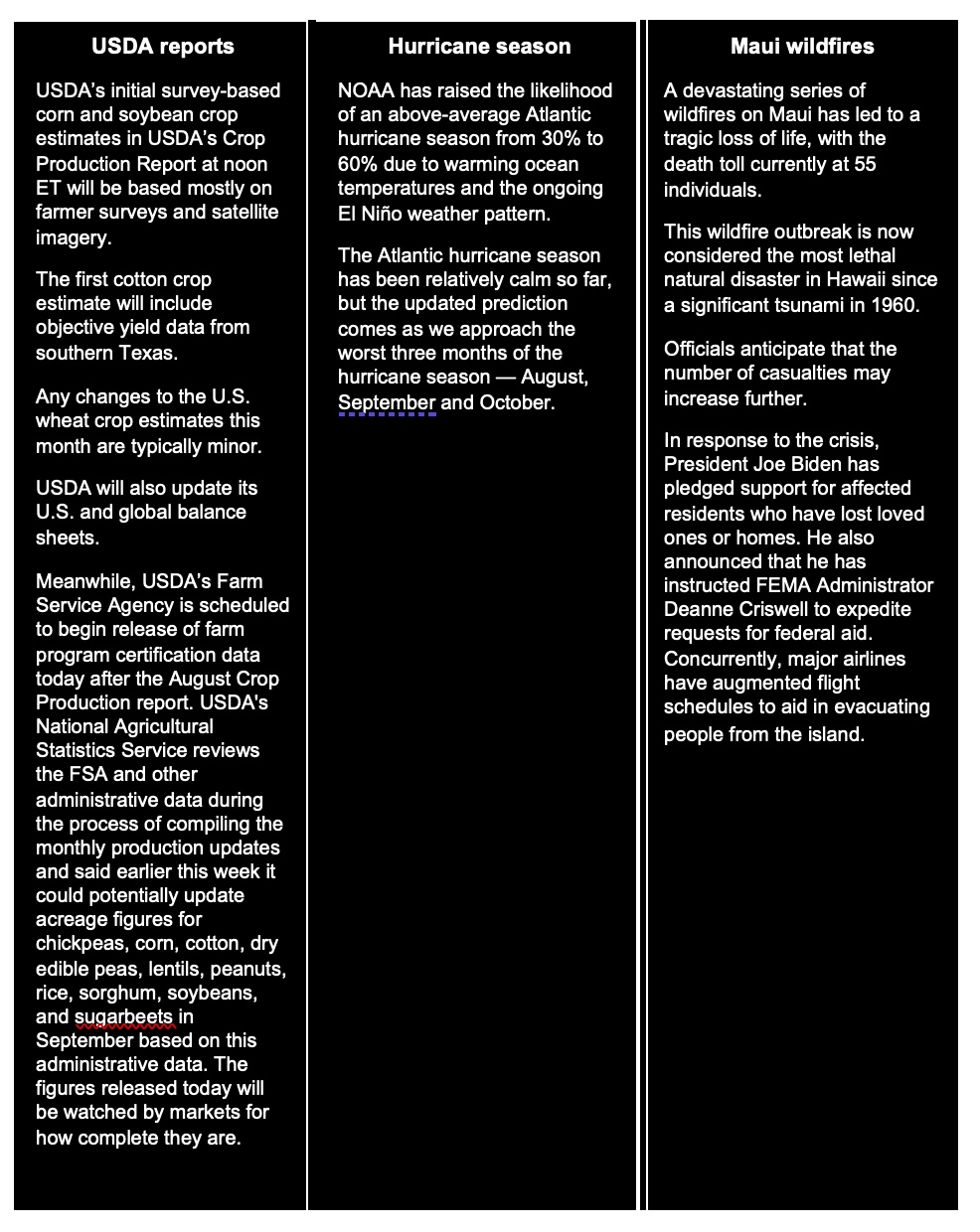
|
Today’s Digital Newspaper |
USDA daily export sale: 143,637 metric tons corn to Mexico during 2023-24 marketing year.
Wholesale prices in July rose 0.3%, with an annual increase of 0.8%. Both came in hotter than estimates. Core prices, excluding food and energy, moved up 0.3% from June, with a 2.4% year-over-year jump. Both were also hotter than expected. An uptick in wholesale prices could be signaling higher consumer inflation ahead.
American workers are experiencing a reversal as their wages are now outpacing inflation.
Global oil demand has surged to a record amid robust consumption in China and elsewhere, threatening to push prices higher, the International Energy Agency said. World fuel use averaged 103 million barrels a day for the first time in June and may soar even higher in August, the agency said. Details below.
A potential disruption in global natural gas supplies is emerging due to a labor dispute at major Australian energy companies.
President Joe Biden requested $40.1 billion in emergency funding, which would encompass aid for Ukraine, disaster relief, and various other purposes. This proposal aims to bypass budget limitations and could further complicate the already contentious appropriations process. If approved, the supplementary spending package is expected to be included in a temporary funding bill that Congress must pass in the coming month to prevent a partial government shutdown.
President Biden calls China a “ticking time bomb” because of economic problems. At a political fund-raiser, Biden pointed to weak growth, high unemployment and an aging work force and warned that countries in trouble often do “bad things.” A day earlier, the president issued an executive order to restrict investments in key tech sectors in China.
The U.K. economy delivered its strongest quarterly growth in more than a year, a surprising show of resilience that will keep pressure on the Bank of England to raise rates further.
U.S. budget deficits are on the rise. Details below.
The official statement following a meeting between Deputy U.S. Trade Representative Jayme White and Mexican Under Secretary of Economy for Foreign Trade Alejandro Encinas did not mention any discussion about the ongoing dispute concerning Mexican regulations on the import of genetically modified (GMO) corn for food purposes. More in Trade Policy section.
The U.S. has reportedly halted the unloading of a shipment of Polish wheat destined for Houston, which could potentially lead to tensions with the European Union.
Grocery prices in the U.S ticked up slightly last month, driven largely by the rising cost of beef. Restaurants are also raising prices, new data shows, as their own expenses have gone up and as diners seem to be accepting more expensive menu items. More in Food section.
West Virginia Senator Joe Manchin, a Democrat, is considering the possibility of leaving the Democratic Party and declaring himself an independent before the 2024 election.
Nearly 50,000 Americans took their own lives in 2022, the highest number on record, provisional data from the CDC released Thursday showed, as the suicide epidemic in the U.S. reaches a grim new mark.
14: The number of named storms produced in an average Atlantic hurricane season, of which on average seven become hurricanes and three major hurricanes, according to the National Oceanic and Atmospheric Administration. Details below.
|
MARKET FOCUS |
Equities today: Asian and European stock markets were mostly lower in overnight trading. U.S. Dow opened around 50 points lower as the PPI info came in hotter than expected. In Asia, Japan +0.8%. Hong Kong -0.9%. China -2%. India -0.6%. In Europe, at midday, London -1%. Paris -0.7%. Frankfurt -0.4%.
U.S. equities yesterday: U.S. equities ended with modest gains after inflation data released before the open. The Dow rose 52.79 points, 0.15%, at 35,176.15. The Nasdaq was up 15.97 points, 0.12%, at 13,737.99. The S&P 500 edged up 1.12 points, 0.03%, at 4,468.83.
Stocks are on track for a mostly negative week, with the S&P 500 index down by 0.2% and the Nasdaq Composite index down by 1.23% as of now. If this trend continues, both indexes would experience their second consecutive week of decline. The Nasdaq hasn't seen back-to-back weekly losses since December. In contrast, the Dow is the only index that has shown gains this week, with an increase of 0.3%.
Agriculture markets yesterday:
- Corn: December corn futures rose 2 cents to $4.96 1/4, ending nearer the intraday high.
- Soy complex: November soybeans rose 9 3/4 cents to $13.18 1/4, a mid-range close, while September meal rose $2.30 to $415.00. September soyoil fell 3 points to 64.18 cents.
- Wheat: December SRW wheat rose 2 cents to $6.63 3/4. December HRW wheat gained 3 1/4 cents to $7.79 1/4. December spring wheat fell 2 1/4 cents to $8.33 1/4. Prices closed nearer their session lows.
- Cotton: December cotton rose 80 points to 86.15 cents, marking the highest close since July 26.
- Cattle: October live cattle rose 82 1/2 cents to $182.525 and nearer the session high. October feeder cattle gained $1.175 at $253.325 and near mid-range.
- Hogs: Expiring August lean hog futures edged up 7.5 cents to $101.725 Thursday, while most-active October fell $1.25 to $80.325.
Ag markets today: Corn, soybeans and wheat traded in relatively tight ranges during the overnight session as traders awaited USDA’s August crop reports later this morning. As of 7:30 a.m. ET, corn futures were trading fractionally lower, soybeans were 5 to 6 cents higher, SRW wheat was 3 to 4 cents lower, HRW and HRS wheat were steady to fractionally higher. Front-month crude oil futures were around 50 cents higher, and the U.S. dollar index was trading just below unchanged.
Market quotes of note:
- China and the ‘D-word.’ “That talk of diversification, de-risking, decoupling, disentangling—choose your ‘D-word,’ whichever one you like — it’s really baked into the minds in Washington, increasingly in Silicon Valley, and this is really being beamed right at Wall Street." — Liza Tobin, a former National Security Council official now with the Special Competitive Studies Project, on the Biden administration executive order banning trade with China in certain sensitive high-technology areas.
- U.S. inflation report assessment. Bank of America’s Michael Gapen and Stephen Juneau called the latest CPI figure “encouraging,” adding that “we wouldn’t be surprised to see another soft August print given declines in wholesale used car prices.”
- Food and fuel prices remain wild cards. “The recent sharp rise in crude oil, diesel and gasoline prices pose substantial upside risks to headline inflation in August,” Mahmoud Abu Ghzalah, an economist at Berenberg Capital Markets, wrote in a client note. Another assessment: “With oil prices and gasoline prices edging higher, the Fed may feel compelled to conclude its rate hike campaign with one last ‘insurance’ rate hike — but could now wait until the November meeting to decide,” Quincy Krosby, chief global strategist for LPL Financial, wrote in a research note.
Thursday’s encouraging inflation data took air out of traders' bets that the Federal Reserve would raise rates again this year.
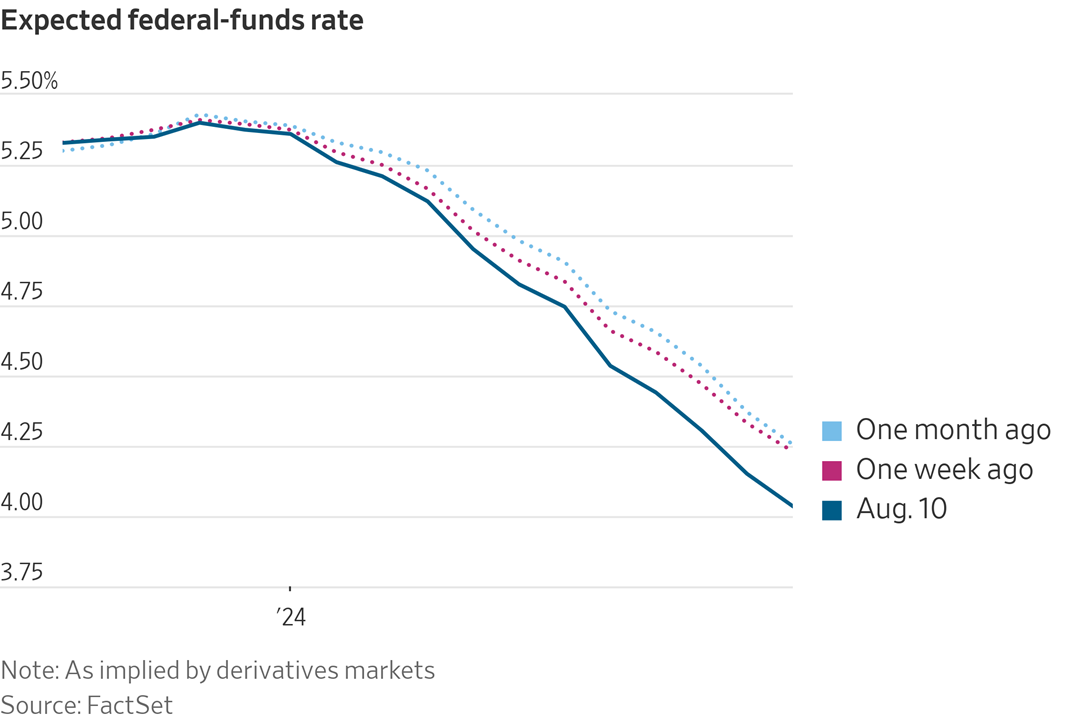
The U.K. economy has pleasantly surprised by achieving its most robust quarterly growth in over a year. During the second quarter, the Gross Domestic Product (GDP) increased by 0.2%, surpassing predictions of stagnation. Notably, the output in June surged at a rate more than twice what was anticipated. This data has fueled speculations that there might be additional increases in interest rates. Following the release of this report, the British pound gained strength against the U.S. dollar.
U.S. budget deficit for fiscal year (FY) 2023 has expanded to $1.6 trillion, a considerable increase compared to the previous year. In the latest monthly report from the U.S. Treasury, a budget deficit of $220.8 billion was recorded, with gov’t receipts rising by 2.5% to $276 billion and spending increasing by 3.4% to $497 billion. These figures have contributed to the cumulative deficit reaching $1.6 trillion for the first ten months of FY 2023, which is more than double the amount from the same period one year ago.
Within the current fiscal year, receipts have decreased by 10% to $3.7 trillion, while spending has risen by 10% to $5.3 trillion.
Notably, interest payments on the federal debt amounted to $67 billion in July, and these payments have totaled $725 billion so far in FY 2023. This is in comparison to $589.5 billion during the same period in FY 2022.
Recall CBO’s estimate for the total FY 2023 deficit is $1.7 trillion. CBO said they are now looking for both outlays and receipts to be smaller for the balance of FY 2023 than they had forecast in May, but they noted that the new income-driven repayment plan for student loans will provide some increased government receipts.
Real wages rise. American workers are experiencing a reversal as their wages are now outpacing inflation. In July, real average hourly earnings rose by 0.3% compared to the previous month and by 1.1% compared to the same period last year, according to the Labor Department. A prolonged period from April 2021 to April 2023 saw inflation surpassing annual average wage growth, which impacted workers' purchasing power. However, the situation has now shifted, as inflation is moderating while there remains a high demand for workers. This change has the potential to encourage increased consumer spending, which could contribute to overall economic growth.
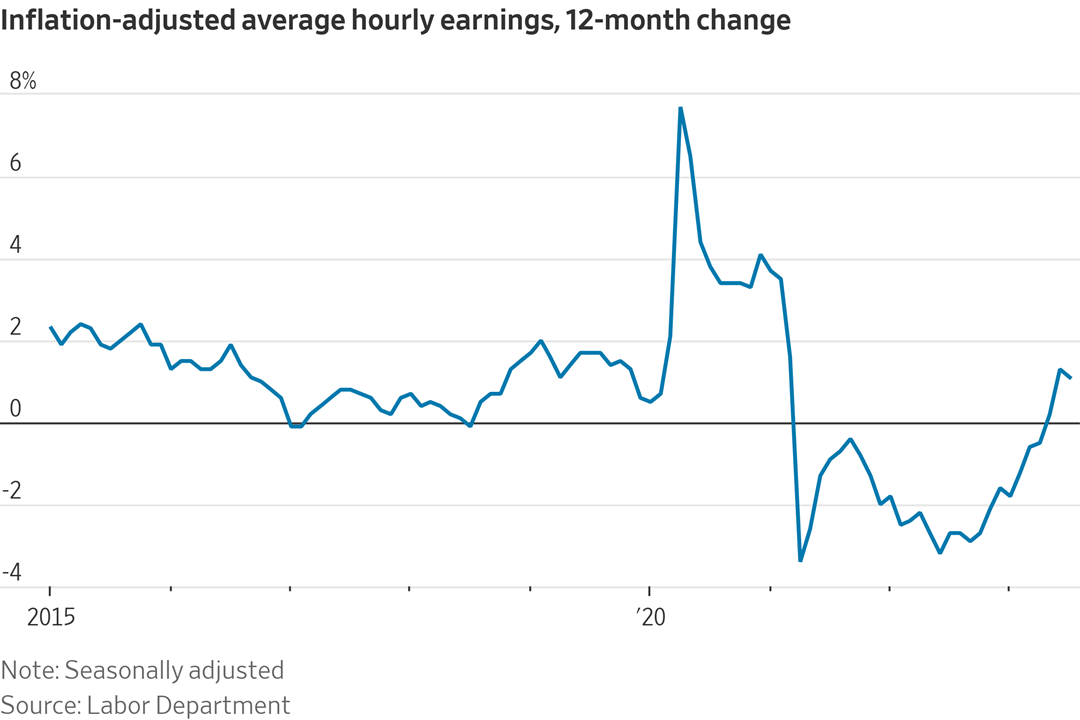
The Social Security cost-of-living adjustment (COLA) for 2024 is anticipated to be relatively modest due to a deceleration in inflation. If inflation follows its recent trajectory in the coming two months, beneficiaries can expect their monthly payments to increase by approximately 3% in 2024, the Wall Street Journal reports (link), echoing other recent forecasts. This estimate is based on analyses conducted by experts and nonprofit organizations. In contrast, the COLA for 2023 was significantly higher at 8.7%, reflecting the surge in inflation during that period.
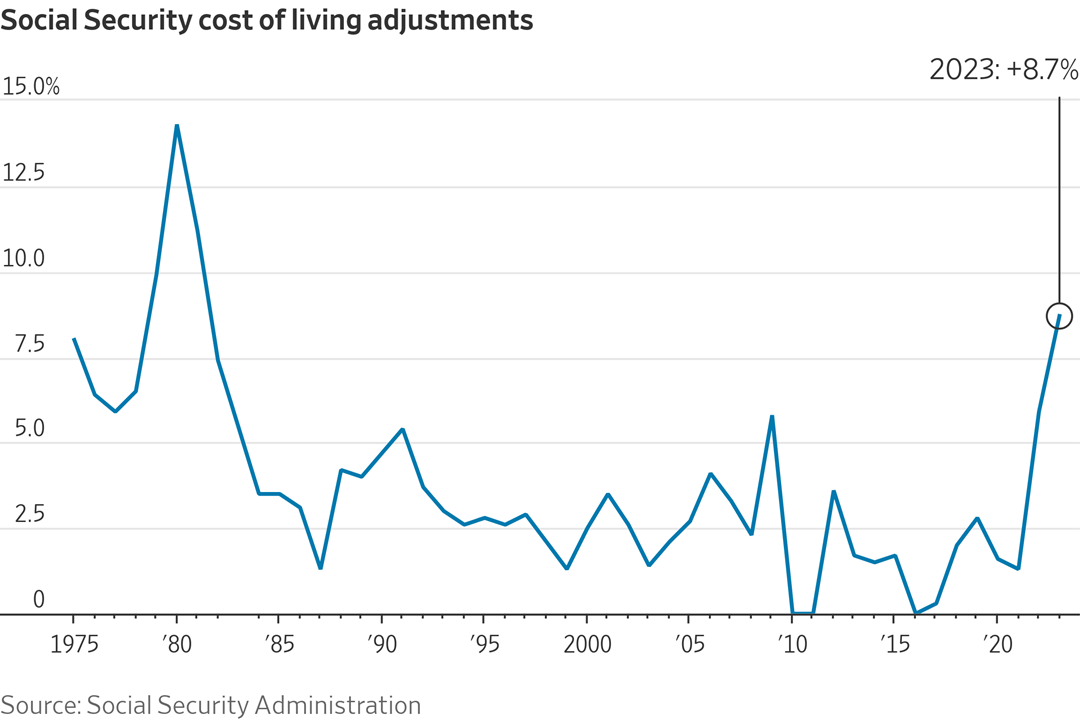
U.S. recession: yes, or no? While some big banks have walked back their recession warnings lately, plenty remain unconvinced, as show in this Bloomberg-generated update:
R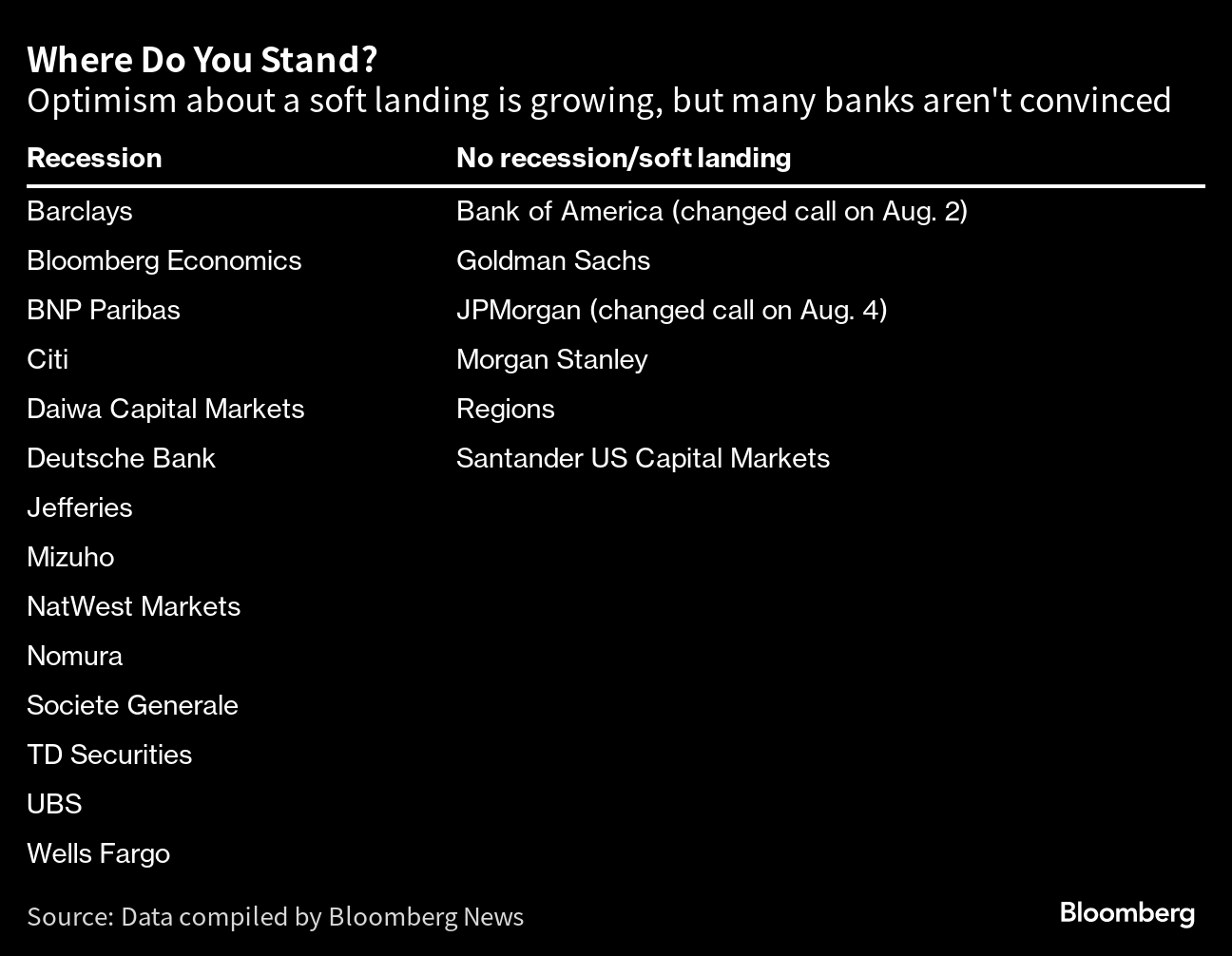
Market perspectives:
• Outside markets: The U.S. dollar index was slightly weaker as the euro and British pound were both firmer against the greenback ahead of wholesale inflation data. The yield on the 10-year U.S. Treasury note was slightly lower, trading around 4.10%, with a mostly firmer tone in global government bond yields. Crude oil futures were higher, with U.S. crude around $83.15 per barrel and Brent around $86.80 per barrel. Gold and silver were narrowly mixed, with gold firmer around $1,950 per troy ounce, and silver weaker around $22.77 per troy ounce.
• Global oil demand has reached a new all-time high, driven by strong consumption in China and other regions, which is raising concerns about potential price increases, according to the International Energy Agency (IEA). In June, worldwide fuel usage averaged 103 million barrels per day, a record figure, and this demand is expected to surge even further in August. With Saudi Arabia and its allies intentionally reducing supplies, the global oil market is tightening significantly.
Reasons for demand surge. The IEA, based in Paris, attributes this surge in oil demand to factors like robust summer air travel, increased oil usage in power generation, and a notable rise in Chinese petrochemical activity. This demand has led to substantial reductions in crude oil and product inventories, creating a tightening market situation that is expected to continue into the autumn.
Despite previous concerns about the plateauing of oil demand due to the pandemic's impact and global efforts to shift away from fossil fuels for environmental reasons, the IEA's data suggests that oil consumption is stronger than ever. Notably, China is projected to account for around 70% of this year's demand growth, with developed nations also contributing unexpectedly.
Looking ahead, the energy transition is likely to have more pronounced effects next year, as global demand growth is projected to halve to around 1 million barrels per day due to increased vehicle efficiency and greater adoption of electric cars. In the present moment, however, global oil markets are tightening, leading to inventories in developed nations falling about 115 million barrels below their five-year average. The IEA anticipates a substantial depletion of global stockpiles at a rate of 1.7 million barrels per day during the second half of the year.
While some major consuming nations have criticized Saudi Arabia and its allies in the OPEC+ alliance for constraining supplies and potentially driving inflation, the IEA indicates that the market conditions might push oil inventories even lower, potentially leading to further price increases if current production targets are maintained by OPEC and its partners.
• A potential disruption in global natural gas supplies is emerging due to a labor dispute at major Australian energy companies, the Wall Street Journal reports (link). This issue is causing concerns among importers, who fear that deliveries from one of the world's leading gas exporters might be impacted. This situation is particularly worrisome for Europe, as it approaches its second winter since Russia's actions in Ukraine led to a reduction in Russian gas supplies. Despite Australia's main commitment of its gas supply to Asia, a sudden decrease in liquefied natural gas (LNG) exports could trigger a competitive bidding situation for gas from other sources, including the United States. These concerns underscore the vulnerability of global LNG supply chains, even as efforts are made to increase production and export capacity. An analyst estimates that the strike-affected export facilities in Australia accounted for approximately 12% of global LNG exports in the previous year, based on ship-tracking data.

• Vietnam’s rice exports likely to increase this year. Vietnam will have 7 MMT to 8 MMT of rice to export this year, according to Vietnam News Agency, citing the country’s ag minister. Last year, Vietnam exported 7.1 MMT of rice. During the first seven months of this year, the country’s rice exports totaled 4.89 MMT, up 21% from the same period last year.
• Ag trade: Algeria purchased an unknown volume of corn expected to be sourced from Argentina from a tender for up to 80,000 MT.
• The National Oceanic and Atmospheric Administration (NOAA) has raised its projection for the 2023 Atlantic hurricane season, indicating an expectation of more active hurricane activity than previously anticipated. The Climate Prediction Center (CPC), a branch of NOAA, has upgraded their outlook from initially predicting a season with average activity to now forecasting an above-normal level of activity. According to NOAA's meteorologists, there is now a 60% likelihood of an above-normal hurricane season. In contrast, the chances of a season with average activity have been decreased to 25% (previously 40%), and the probability of a below-normal season is only 15%.
This revised outlook predicts the formation of 14 to 21 named storms, characterized by wind speeds of at least a certain threshold (miles per hour or greater). Among these storms, 6 to 11 are expected to intensify into hurricanes, and among those, 2 to 5 might develop into major hurricanes. NOAA has expressed a confidence level of 70% in these projected ranges.
This shift in the forecast is attributed to current oceanic and atmospheric conditions. Notably, the sea surface temperatures in the Atlantic Ocean are unusually warm, which counteracts the usual atmospheric conditions that would typically limit hurricane development. This phenomenon is being influenced by the ongoing El Niño event. El Niño conditions are currently being observed, and the CPC's latest outlook indicates a greater than 95% likelihood that El Niño will persist throughout the upcoming winter in the Northern Hemisphere.
An elevated forecasted level of activity does not automatically translate to all projected storms making landfall. Instead, the focus will be on monitoring storms that might pose a threat to densely populated areas or to activities like energy exploration concentrated mainly in the Gulf of Mexico. In essence, while the updated forecast suggests a higher likelihood of above-normal hurricane activity, the precise impact on specific regions remains uncertain.
• NWS weather outlook: Dangerous heat will persist across much of the southern tier of the U.S... ...Severe thunderstorms possible today for the Midwest and Saturday for the Ohio Valley/Northeast... ...Monsoonal showers for the Four Corners region with generally below to near average temperatures in the West.
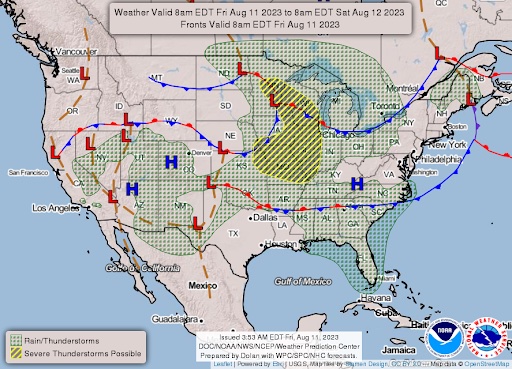
Items in Pro Farmer's First Thing Today include:
• Quiet grain trade overnight
• U.S. halts cargo of Polish wheat
• Russia sharply raises wheat export tax
• More downbeat economic data out of China
• Quiet cash cattle market
• Cash hog pullback extends
|
RUSSIA/UKRAINE |
— President Joe Biden is seeking approval from Congress for over $24 billion in aid, including funds for Ukraine and other international needs. This is part of a new $40 billion request to Congress to pay for items the administration termed critical. With a focus on sustaining support for Ukraine's ongoing conflict, this request encompasses more than $13 billion for security assistance and $7 billion for economic and humanitarian aid in Ukraine. However, this proposal could lead to potential disagreements with congressional Republicans. While Biden has pledged unwavering support for as long as needed, the Republican Party's skepticism has raised doubts about the future extent of U.S. involvement. A recent CNN poll indicated that 55% of Americans believe that Congress should not authorize additional funding to support Ukraine.
Congress has already authorized $110 billion in military, economic and humanitarian assistance for Ukraine since Russia invaded the country last year.
The current request includes about $12 billion for recovery from natural disasters, and billions of dollars more to protect the southern border along with additional funds to stem drug trafficking. The billions requested for disaster responses includes fighting wildfires. Roughly 20,000 firefighters will see their salaries cut as soon as October if the funding isn’t approved, according to the Biden administration.
— Ukraine has harnessed the power of small, low-cost homemade drones to establish a fresh battleground in the conflict, targeting significant military assets and symbols of Russia's influence in the Black Sea, the Wall Street Journal reports (link). These easily deployed drones have enabled Ukraine to attack strategic military sites. Military experts highlight that these surface drones have the potential to compel Russia to allocate more resources toward safeguarding its ports, warships, and cargo vessels that play a crucial role in transporting supplies, including weapons and fuel, for its military activities. The attacks are anticipated to elevate both shipping and insurance expenses for ships bound for Russia's vital Black Sea ports. In essence, the utilization of these drones is creating a dynamic that challenges Russia's dominance in the region and potentially adds economic pressures to its maritime operations.
|
CHINA UPDATE |
— President Biden characterized China's economy as a "ticking time bomb" and criticized the leaders of the Communist Party, referring to them as "bad folks." At a political fundraiser, he pointed to China's economic slowdown, the fact that people of retirement age outnumber those of working age, and referred to the Belt and Road Initiative as a "debt and noose." "They got some problems," Biden declared. "That's not good because when bad folks have problems, they do bad things." These comments represent another instance of Biden's criticism toward President Xi Jinping's government and comes despite ongoing efforts by his administration to enhance the overall relationship with Beijing.
In response, China's official news agency, Xinhua, strongly rebuked Biden's statements. The commentary labeled Biden's comments as employing an "old trick" of targeting China when there are domestic issues at play.
— China restrictions on group tours to several countries, including the U.S., Australia, South Korea, and Japan. This decision is expected to rejuvenate international tourism following three years of limitations due to the pandemic. Chinese tourists are now permitted to travel in organized groups to nearly 140 countries globally. Prior to the pandemic, Chinese tourists were the world's largest spenders on travel, having expended $255 billion overseas in 2019, as indicated by International Monetary Fund data. In comparison, U.S. tourists, who ranked second, spent just over half that amount.
— Assessing damage to China’s corn, rice crops from storm impacts. Floods have damaged corn and rice crops in China’s key northern grain belt, with more rains expected from Khanun, though World Weather Inc. doesn’t expect serious damage from the latest storm. Initial estimates show 4 MMT to 5 MMT of corn, or about 2% of the country’s output, have been affected by the floods, two trade sources told Reuters. An analyst at Beijing Orient Agribusiness Consultant told Reuters damage from the storms may reduce rice production by 3% to 5%. China’s ag ministry left its corn and soybean production estimates at 282.34 MMT and 21.46 MMT, respectively. Any reductions due to recent flooding and adverse weather will likely show up in next month’s report.
|
TRADE POLICY |
— GMO corn trade flap absent from USTR readout of meeting with Mexican official. The official statement following a meeting between Deputy U.S. Trade Representative Jayme White and Mexican Under Secretary of Economy for Foreign Trade Alejandro Encinas did not mention any discussion about the ongoing dispute concerning Mexican regulations on the import of genetically modified (GMO) corn for food purposes. Instead, the statement indicated that the officials addressed matters related to discussions at the Third Free Trade Commission meeting of the U.S.-Mexico-Canada Agreement (USMCA) held the prior month in Mexico.
The released statement noted the focus on enhanced collaboration to prevent imports of goods produced through forced labor. Additionally, Deputy USTR White raised concerns about the recent increase in imports of Mexican steel and aluminum, as well as issues concerning regulatory clarity for electronic payment service providers operating in Mexico. Both White and Encinas agreed to maintain regular communication to address these and other significant issues pertaining to the economic relationship between the United States and Mexico.
— Japan lifts ban on Brazil’s Espirito Santo chicken products. The Japanese government lifted restrictions on chicken products from the Brazilian state of Espirito Santo, which it imposed after bird flu cases in local backyard flocks in late June, Brazilian agriculture ministry said. Japan was Brazil’s second largest destination for chicken exports in the first half of this year.
— The U.S. has reportedly halted the unloading of a shipment of Polish wheat destined for Houston, which could potentially lead to tensions with the European Union (EU), Bloomberg reports. The vessel Yochow, carrying around 30,000 tons of Polish wheat, is being held at the port due to concerns over contamination with corn. This move comes as the U.S. has turned to European wheat imports due to local price increases caused by drought. Despite sufficient American supplies for domestic flour mills, importing grain from Poland is more cost-effective than transporting it from the Midwest to places like Texas and Florida.
This unusual situation poses challenges for U.S. farmers who have been losing ground in the global market to major exporter Russia. A decision to definitively reject the cargo could strain relations with the EU. Previously, the U.S. has accused other countries of using non-tariff trade barriers when American shipments were denied entry in nations such as China.
Details: The ship Yochow departed from Poland on July 13 and reached Houston on Aug. 6. EU data indicates that in July, two shipments totaling around 29,000 and 33,000 tons respectively sailed from Poland to the U.S.
|
LIVESTOCK, FOOD & BEVERAGE INDUSTRY |
— Grocery prices in the U.S ticked up slightly last month, driven largely by the rising cost of beef. Restaurants are also raising prices, new data shows, as their own expenses have gone up and as diners seem to be accepting more expensive menu items.
In July, the cost of various cuts of uncooked beef saw significant increases. Adjusted for seasonal variations, uncooked beef roasts surged by 6.5%, uncooked beef steak prices rose by 2.3%, and uncooked ground beef experienced a 1.5% price increase. When taken as a whole, the cost of beef and veal rose by 2.4% in the same month.
These price hikes have occurred against a backdrop of decreasing beef supplies in the country. Years of extreme drought conditions prompted farmers to rapidly sell off cattle due to high feed costs and the inability to sustain herds. This trend, particularly the sale of breeding cows, led to supply constraints in the present year.
|
HEALTH UPDATE |
— Nearly 50,000 Americans took their own lives in 2022, the highest number on record, provisional data from the CDC released Thursday showed, as the suicide epidemic in the U.S. reaches a grim new mark. Adults 65 and older recorded the largest increase among the age categories the agency tracks, with suicide rates up 8.1% from 2021.
— Covid-19 infections are rising in the U.S. A new Omicron subvariant, called EG.5 and unofficially dubbed “Eris,” has been reported in at least 51 countries since Monday, according to the WHO, which classified it as a variant of interest. In the U.S., EG.5 is projected to represent roughly 17% of cases as of Aug. 5, making it the most prevalent version of the virus in the country, according to the CDC. Like other Omicron subvariants, EG.5 has immune-escape properties, but there are no signs it is more severe, the WHO said.
— The Supreme Court has blocked Purdue Pharma's $6 billion settlement of opioid-related lawsuits. The Court agreed to consider the Justice Department's argument that the pharmaceutical company's bankruptcy plan improperly eliminates potential liability to other parties for contributing to the opioid addiction crisis. The Sackler family, who owns Purdue Pharma, has made the release from liability a condition for paying the settlement. This settlement is significant as it would conclude Purdue's bankruptcy and stands as one of the largest legal resolutions arising from the opioid epidemic.
Impact: By agreeing to hear the case and halting Purdue's settlement during the appeal, the Supreme Court has effectively delayed or even jeopardized a significant portion of funds that the pharmaceutical industry had pledged to address the opioid crisis. However, this decision might eventually provide an opportunity for parties that were dissatisfied with the original settlement to secure additional compensation.
|
POLITICS & ELECTIONS |
— Manchin ‘thinking seriously’ about bolting Democratic Party. West Virginia Senator Joe Manchin, a Democrat, is considering the possibility of leaving the Democratic Party and declaring himself an independent before the 2024 election. During an interview with West Virginia radio host Hoppy Kercheval, Manchin expressed his concerns about the negative perception of both the Democratic and Republican brands, describing the Democratic brand as "bad." He highlighted that he doesn't align himself with the image of a typical Washington Democrat and emphasized his desire for an independent voice that can address the extreme elements of both major parties that he believes are detrimental to the country. Manchin mentioned that he has been contemplating this move for a while, aiming to ensure his voice truly represents independence when he speaks out on political matters. This potential decision could influence whether he pursues a fourth Senate term or considers a third-party presidential bid in the upcoming election.
|
OTHER ITEMS OF NOTE |
— Cotton AWP edges higher. The Adjusted World Price (AWP) for cotton moved up slightly to 70.25 cents per pound, effective today (Aug. 11), a rise from 70.19 cents per pound the prior week. Meanwhile, USDA said that Special Import Quota #17 would be established Aug. 17 for the import of 58,062 bales of upland cotton, applying to quantities purchased not later than Nov. 14 and entered into the U.S. not later than Feb 12, 2024.
|
KEY LINKS |
WASDE | Crop Production | USDA weekly reports | Crop Progress | Food prices | Farm income | Export Sales weekly | ERP dashboard | California phase-out of gas-powered vehicles | RFS | IRA: Biofuels | IRA: Ag | Student loan forgiveness | Russia/Ukraine war, lessons learned | Russia/Ukraine war timeline | Election predictions: Split-ticket | Congress to-do list | SCOTUS on WOTUS | SCOTUS on Prop 12 pork | New farm bill primer | China outlook | Omnibus spending package | Gov’t payments to farmers by program | Farmer working capital | USDA ag outlook forum | Debt-limit/budget package |






